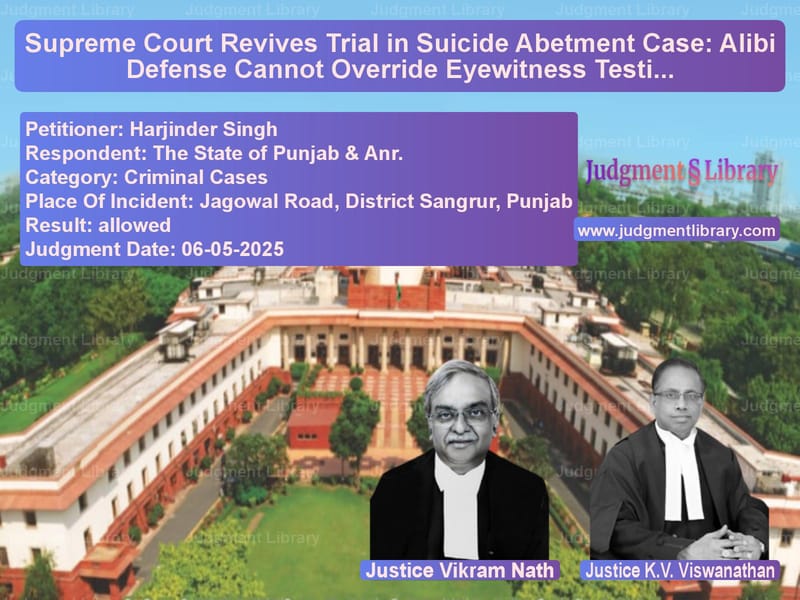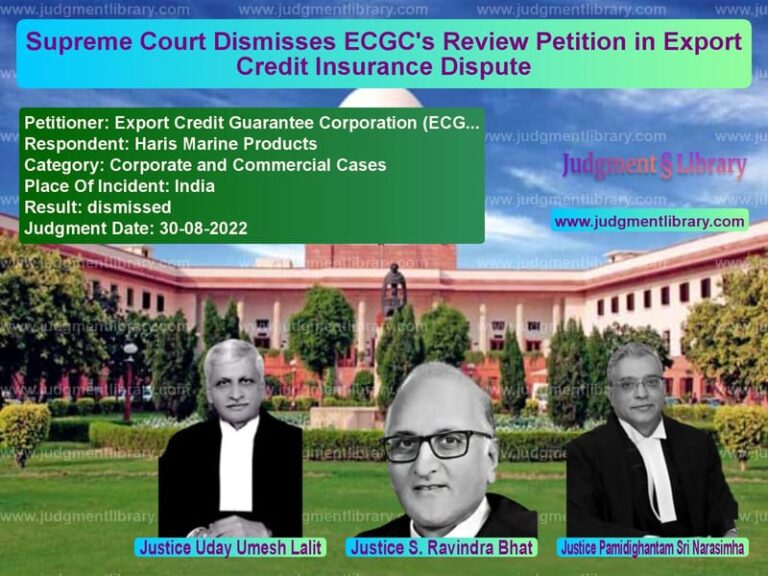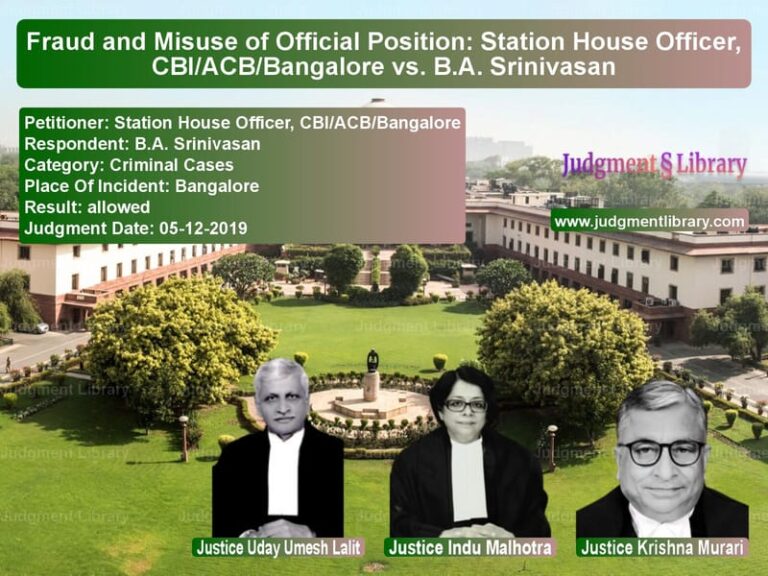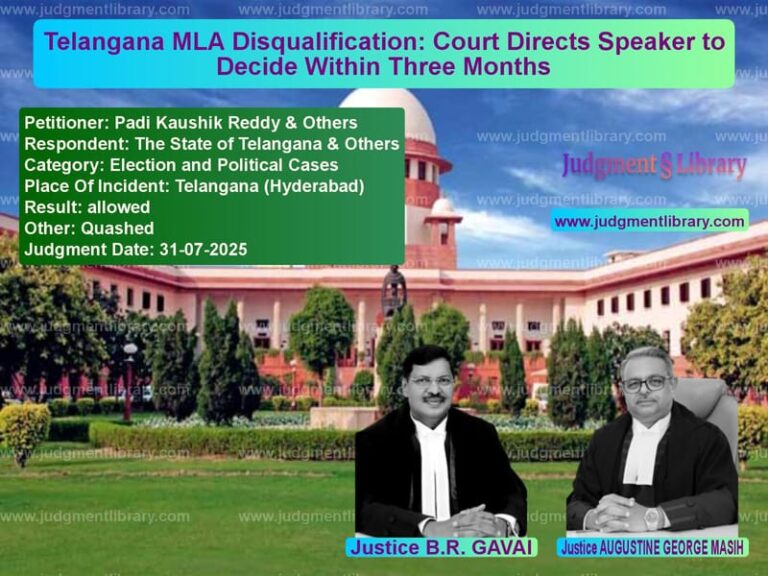Supreme Court Revives Trial in Suicide Abetment Case: Alibi Defense Cannot Override Eyewitness Testimony
In a significant ruling that clarifies the scope of judicial powers to summon additional accused during trial, the Supreme Court of India has reinstated the criminal proceedings against Varinder Singh in a tragic suicide case. The judgment, delivered on May 6, 2025, overturns the Punjab and Haryana High Court’s decision and emphasizes that untested alibi defenses cannot override credible eyewitness testimony at the stage of summoning an accused.
The case revolves around the tragic death of Dharminder Singh, who took his own life by jumping into the Hussainpur canal on May 10, 2016. The deceased’s father, Harjinder Singh, alleged that his son was driven to suicide following a confrontation with Varinder Singh and others who had taunted the young man about his family’s failure to take action against perpetrators of an earlier acid attack.
The Tragic Sequence of Events
The background of this case reveals a heartbreaking story of trauma and alleged harassment. On March 13, 2016, Dharminder Singh became the victim of a brutal acid attack recorded as FIR No. 30 of 2016 under various sections including the stringent Section 326-A IPC. While Varinder Singh was not named in that initial case, the subsequent events would bring him under legal scrutiny.
The fateful incident occurred on May 10, 2016, at around 8:30 in the morning. Dharminder Singh and his paternal uncle Jagdev Singh were standing near their agricultural land on Jagowal Road when Varinder Singh, Gurmail Singh, Santokh Singh, and Iqbal Singh, accompanied by an unidentified person, allegedly stopped their white car and confronted the deceased. According to the prosecution, they taunted Dharminder Singh, stating that he and his family “should die of shame” for not having taken action against the acid-attack assailants.
The impact of these words was immediate and devastating. The deceased returned home in distress, locked himself in a room, and left the house alone at about 4:00 p.m. When he did not return by evening, his family grew worried and organized a search party. Their worst fears were confirmed when they found his bicycle, clothing, and footwear near the Hussainpur canal. Three days later, on May 13, 2016, his body was recovered from the canal head at village Salar. The same day, his father lodged a complaint leading to the registration of FIR No. 51 of 2016 under Sections 306/34 IPC, naming Varinder Singh among the accused.
The Legal Battle Unfolds
During the investigation, the police accepted the plea of alibi advanced by Varinder Singh, who produced a parking-lot slip, outpatient records, a medicine bill, and CCTV footage from PGI Chandigarh timed from 6:30 a.m. onward on May 10, 2016. Based on these materials, the investigating officer filed a report under Section 173(2) CrPC on August 2, 2016, classifying Varinder Singh as “innocent.” Consequently, only the remaining accused were committed to the Court of Session.
The case took its first legal turn when the Trial Court, on an application by the Public Prosecutor, summoned Varinder Singh under Section 193 of CrPC on January 20, 2017. However, Varinder Singh successfully challenged this order before the High Court, which quashed the summoning on November 24, 2021, citing the absence of a committal order while granting liberty to invoke Section 319 CrPC if credible evidence emerged during trial.
The crucial development occurred during the trial when the appellant, Harjinder Singh, testified as PW-1 on March 8, 2022, narrating the confrontation of May 10, 2016, and attributing direct participation to Varinder Singh. Relying on this sworn testimony and the statement of Jagdev Singh recorded under Section 161 CrPC, the Public Prosecutor moved an application under Section 319 CrPC to summon Varinder Singh.
The Trial Court allowed this application on July 4, 2022, observing that PW-1’s sworn testimony, corroborated by Jagdev Singh’s statement, disclosed a prima facie case and that the plea of alibi was a matter for trial. The court directed Varinder Singh to appear on August 2, 2022, to stand trial alongside the existing accused for the offence under Section 306 IPC.
The High Court’s Intervention
Varinder Singh approached the High Court under Section 482 CrPC, asserting that the Trial Court had disregarded what he described as “scientific and documentary proof” of his whereabouts in Chandigarh at the relevant time. He insisted that only substantially stronger evidence could justify his addition to the array of accused.
The High Court, persuaded by these submissions, took the view that the Trial Court ought to have weighed the investigation record, including the parking slip, CCTV footage, and associated inquiries. On November 21, 2023, the High Court set aside the summoning order, concluding that the material adduced fell short of the rigor demanded for invoking Section 319 CrPC.
Arguments Before the Supreme Court
Before the Supreme Court, the appellant’s counsel advanced several crucial arguments. He contended that the police, while filing the final report under Section 173(2) CrPC, had conflated two distinct occurrences: the acid-attack of March 13, 2016, in which Varinder Singh was not named, and the incident of May 10, 2016, that formed the gravamen of the present FIR. The appellant argued that Varinder Singh’s alibi materials related only to March 10, 2016, and were erroneously treated as exonerating him for the later incident.
The appellant further submitted that Varinder Singh had furnished no cogent alibi for May 10, 2016. The documents he relied upon—parking ticket, OPD card, CCTV clip, and supporting statements—were never exhibited before the Trial Court nor tested in cross-examination, and their veracity could be adjudicated only at trial.
Regarding the eyewitness evidence, the appellant emphasized that Jagdev Singh, whose Section 161 statement specifically attributed the fatal taunts to Varinder Singh, corroborated the sworn testimony of PW-1. Taken together, this constituted prima facie “evidence” arising in the course of trial, satisfying the threshold for exercise of power under Section 319 CrPC.
The appellant criticized the High Court for characterizing the confrontation of May 10, 2016, as mere “teasing” and concentrating on the previous acid attack, thereby undervaluing an independent offence of abetment to suicide that was proximate in time and causally linked to the deceased’s death.
Finally, the appellant argued that by resting its decision on investigation-stage material, the High Court had prematurely evaluated an unproven alibi and overlooked the settled principle that the burden of establishing such a defense lies squarely on the accused and must be discharged through evidence at trial.
The respondents, representing the State of Punjab and Varinder Singh, presented counter-arguments. They emphasized that the police investigation, supported by a parking-slip timed 6:30 a.m., OPD documentation, medical-store bill, CCTV footage, and mobile-tower records, indicated that Varinder Singh was at PGI Chandigarh on May 10, 2016. They pointed out that statements of the parking-attendant and chemist, as well as a village-level inquiry, corroborated this alibi.
The respondents argued that Section 319 CrPC demands evidence stronger than that required even for framing a charge. They contended that the testimony of PW-1 merely reiterated the FIR narrative, while Jagdev Singh’s version remained a Section 161 statement, inadmissible until he enters the witness box.
Highlighting the time-distance matrix, the respondents noted that village Jagowal is about 90 km from Chandigarh, and the CCTV still showed Varinder Singh at PGI at 12:09 p.m., making his presence at the village confrontation improbable. They maintained that the Trial Court had ignored “scientific and documentary” evidence and treated the untested alibi as a matter for trial, thereby reversing the investigative conclusion without any stronger contra-proof.
The Supreme Court’s Analysis
The Supreme Court began its analysis by examining the scope of Section 319(1) of the CrPC, which states: “319. Power to proceed against other persons appearing to be guilty of offence. (1) Where, in the course of any inquiry into, or trial of, an offence, it appears from the evidence that any person not being the accused has committed any offence for which such person could be tried together with the accused, the Court may proceed against such person for the offence which he appears to have committed.”
The Court explained that this provision enables a criminal Court, once seized of the matter, to bring before it any individual whose complicity becomes apparent from the evidence that emerges in Court. It is an exception to the general rule that an accused stands trial only upon charge-sheet and committal; its object is to ensure that the trial does not proceed without a participant who, on the material now available, appears to share criminal liability.
The Court emphasized that while the power is extraordinary and therefore to be exercised with circumspection, it is neither illusory nor deferential to investigative conclusions: once live evidence evinces a prima facie case stronger than mere suspicion, the Court must act.
The judgment extensively referenced the Constitution Bench decision in Hardeep Singh v. State of Punjab, where this Court observed that Section 319 CrPC is designed to ensure that every participant in a crime is brought before the Court and its provisions are therefore to be interpreted constructively and purposively, so that the true offender does not slip through procedural gaps.
The Court quoted directly from the Hardeep Singh judgment: “8. The constitutional mandate under Articles 20 and 21 of the Constitution of India provides a protective umbrella for the smooth administration of justice making adequate provisions to ensure a fair and efficacious trial so that the accused does not get prejudiced after the law has been put into motion to try him for the offence but at the same time also gives equal protection to victims and to society at large to ensure that the guilty does not get away from the clutches of law.”
Further, the Court highlighted: “9. The presumption of innocence is the general law of the land as every man is presumed to be innocent unless proven to be guilty. Alternatively, certain statutory presumptions in relation to certain class of offences have been raised against the accused whereby the presumption of guilt prevails till the accused discharges his burden upon an onus being cast upon him under the law to prove himself to be innocent. These competing theories have been kept in mind by the legislature. The entire effort, therefore, is not to allow the real perpetrator of an offence to get away unpunished. This is also a part of fair trial and in our opinion, in order to achieve this very end that the legislature thought of incorporating provisions of Section 319 CrPC.”
Addressing the specific facts of the case, the Supreme Court noted that PW-1 had narrated in detail how, on the morning of May 10, 2016, Varinder Singh, together with others, stopped a car, confronted the deceased and, in the Punjabi vernacular, told him that he and his family ought to drown themselves for failing to retaliate. PW-1 further described the immediate impact of those words: the deceased broke down, secluded himself, and a few hours later left home never to return alive.
The Court made crucial observations about the alibi defense: “The primary argument of Respondent no. 2 rests on his alibi. An alibi, however, is a plea in the nature of a defence; the burden to establish it rests squarely on the accused. Here, the documents relied upon, parking chit, chemist’s receipt, OPD card, CCTV clip, have yet to be formally proved. Until that exercise is undertaken, they remain untested pieces of paper. To treat them as conclusive at the threshold would invert the established order of criminal proceedings, requiring the Court to pronounce upon a defence before the prosecution is allowed to lead its full evidence.”
The Court also noted practical considerations regarding the alibi: “Even assuming the documents will eventually be proved, their face value does not eclipse the prosecution version. The parking slip is timed at 06:30 a.m.; the chemist’s bill and CCTV images are from 12:09 p.m. The confrontation is alleged at 08:30 a.m. A road journey from Jagowal to Chandigarh of roughly ninety kilometres in a private vehicle can comfortably be accomplished within the intervening window.”
The judgment provided significant insight into the nature of abetment to suicide: “More importantly, abetment to suicide is not an offence committed at a single moment. It may consist of a build-up of psychological pressure culminating in self-destruction, and the law punishes that build-up wherever and whenever it occurs.”
Responding to the argument that the police had accepted the alibi and their conclusion should not be lightly brushed aside, the Court stated: “The submission overlooks the scheme of the CrPC. Once cognizance is taken and trial commences, the investigating agency’s view yields to the Court’s independent assessment. If, in the midst of that trial, evidence implicating a new participant surfaces, the Court is duty-bound to act on it. Section 319 CrPC would be rendered otiose if an Investigating Officer’s earlier opinion could freeze the array of accused for all time.”
The Court firmly rejected the argument that PW-1’s deposition merely reproduces the FIR: “We are unable to agree. A first information report is only an initial version; a statement under oath, recorded in Court, is substantive evidence. Indeed, it is difficult to conceive of what stronger material could be demanded at the summoning stage short of a confession. The threshold is not proof beyond reasonable doubt; it is the appearance of involvement which is apparent from evidence adduced in the proceeding. That threshold was satisfied here.”
The Supreme Court expressed strong disagreement with the High Court’s characterization of the incident as mere “teasing”: “We believe that the High Court, in interfering under Section 482 CrPC, placed decisive reliance on the investigation dossier and characterised the 10 May 2016 episode as mere ‘teasing’. Such a description underplays both the content and the effect of the words spoken. If the allegations is true, telling a physically challenged man that he and his family should die, and doing so in the immediate aftermath of a grievous acid attack, is not banter. Sensitivity to the social context, where honour and shame weigh heavily, was called for.”
The Final Ruling
In its concluding observations, the Supreme Court stated: “Having regard to the purpose of Section 319 CrPC, we see no infirmity in the order of the Trial Court. On the contrary, non-summoning of respondent no. 2 would have risked a truncated trial and a possible failure of justice. The High Court, by elevating unproved defence documents above sworn testimony, adopted an approach that was neither consistent with the text of Section 319 CrPC nor consonant with the realities of a case involving a vulnerable victim. The Court’s intervention, in effect, foreclosed the prosecution from testing the alibi and deprived the Trial Court of jurisdiction expressly conferred upon it.”
The Supreme Court allowed the appeal, set aside the High Court’s judgment dated November 21, 2023, and revived the Trial Court’s order dated July 4, 2022, summoning Varinder Singh to stand trial for the offence punishable under Section 306 IPC. The Court directed Varinder Singh to appear before the Trial Court within four weeks and made it clear that all observations in the judgment were confined to the adjudication under Section 319 CrPC and should not influence the final appreciation of evidence by the Trial Court.
This judgment reinforces the principle that criminal trials must consider all credible evidence of involvement in a crime, and technical defenses like alibi cannot override substantive eyewitness testimony at the preliminary stage of summoning an accused. The ruling ensures that the tragic case of Dharminder Singh will receive a complete and thorough trial with all potentially involved parties present before the court.
Petitioner Name: Harjinder Singh.Respondent Name: The State of Punjab & Anr..Judgment By: Justice Vikram Nath, Justice K.V. Viswanathan.Place Of Incident: Jagowal Road, District Sangrur, Punjab.Judgment Date: 06-05-2025.Result: allowed.
Don’t miss out on the full details! Download the complete judgment in PDF format below and gain valuable insights instantly!
Download Judgment: harjinder-singh-vs-the-state-of-punjab-supreme-court-of-india-judgment-dated-06-05-2025.pdf
Directly Download Judgment: Directly download this Judgment
See all petitions in Suicide Cases
See all petitions in Bail and Anticipatory Bail
See all petitions in Criminal Defamation
See all petitions in Attempt to Murder Cases
See all petitions in Fraud and Forgery
See all petitions in Theft and Robbery Cases
See all petitions in Custodial Deaths and Police Misconduct
See all petitions in SC/ST Act Case
See all petitions in Judgment by Vikram Nath
See all petitions in Judgment by K.V. Viswanathan
See all petitions in allowed
See all petitions in supreme court of India judgments May 2025
See all petitions in 2025 judgments
See all posts in Criminal Cases Category
See all allowed petitions in Criminal Cases Category
See all Dismissed petitions in Criminal Cases Category
See all partially allowed petitions in Criminal Cases Category







